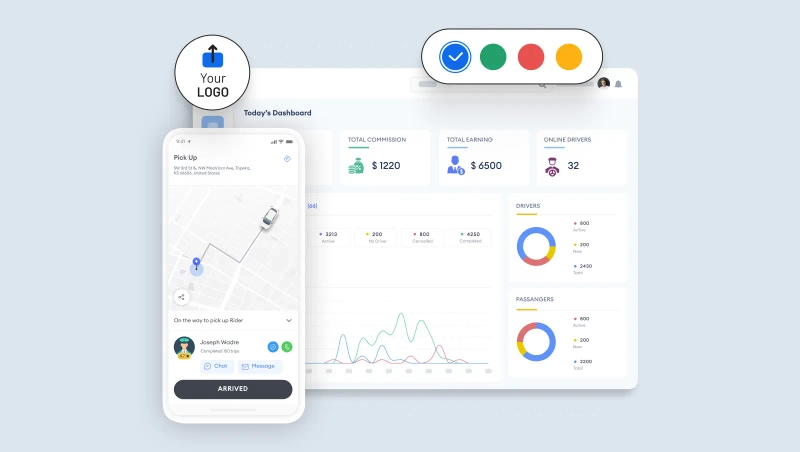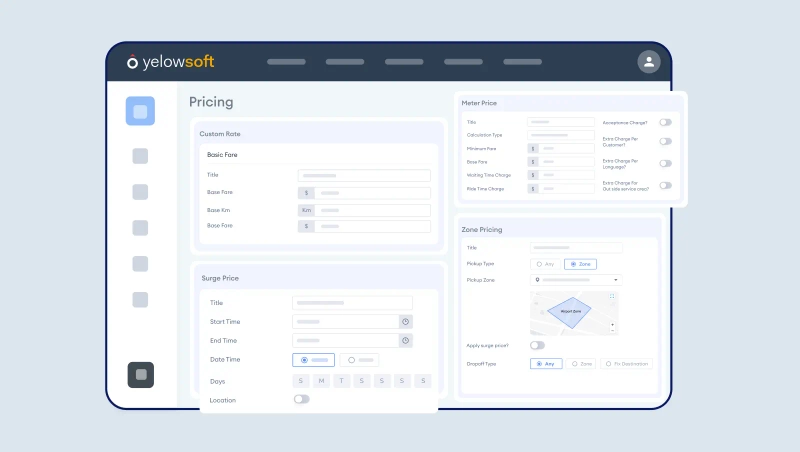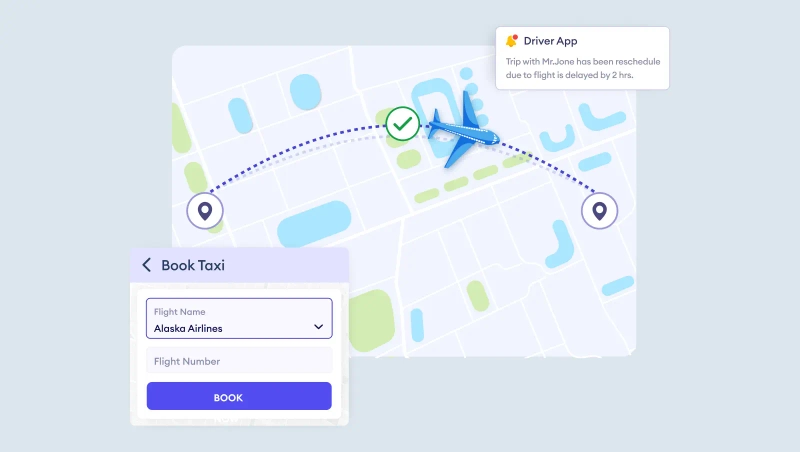The taxi industry has changed drastically. A decade ago, local taxi businesses dominated, and customers had limited choices. Then, ride-hailing giants like Uber and Lyft came in and shook everything up. Traditional taxi businesses struggled to keep up because they weren’t leveraging taxi management software and other advanced tools.
Many taxi companies still operate with outdated methods and rely on manual dispatching, inconsistent pricing, and a lack of digital engagement. Meanwhile, ride-hailing apps are capturing a massive market share by offering seamless experiences, instant ride bookings, and cashless payments.
So, how can you outsmart the competition? The answer lies in technology.
If you run a taxi business or a ride-hailing startup, you might be facing these challenges:
- Losing customers to competitors who offer app-based bookings.
- High operational costs due to manual dispatching and outdated systems.
- Difficulty in managing drivers and optimizing routes.
- Low customer retention because of a lack of engagement tools.
This eBook will help you understand how to use technology to outsmart your competitors.
You’ll also discover how tools like white-label taxi management software, AI-powered dispatch systems, and customer retention strategies can give you a winning edge.
By the end of this guide, you’ll have a clear roadmap to transform your taxi business with top-rated taxi dispatch software and smart tech solutions.
Let’s get started.
Chapter 1: The State of Competition in the Taxi Industry
The taxi industry has undergone massive disruption. Ride-hailing giants have set new customer expectations. It has made it crucial for traditional taxi businesses to adopt modern solutions and stay competitive.
How Competition Has Changed Over the Years?
Traditional taxi businesses relied on radio dispatch and street hailing. Then came mobile apps. Mobile apps made it easier for customers to book rides instantly. Uber, Lyft, and other ride-hailing services introduced tech-driven efficiency, better customer experiences, and cashless payments. This shift changed customer expectations forever.
Customers now demand:
- Real-time tracking to know where their ride is.
- Cashless & contactless payments for safety and convenience.
- Competitive pricing with dynamic fare structures.
- Loyalty rewards to keep them engaged.
Why Are Taxi Businesses Struggling Today?
Here are the biggest challenges that taxi businesses face:
- Lack of Automation: Manual dispatching leads to delays and inefficiency.
- Poor Customer Experience: Without a seamless app, customers prefer ride-hailing platforms.
- High Costs & Low Margins: Fuel, driver commissions, and vehicle maintenance eat into profits.
- Limited Marketing & Branding: It is tough to attract new customers without a strong digital presence.
The Need for a Competitive Edge
To survive and thrive, taxi businesses must adopt technology. Investing in top-rated taxi dispatch software and leveraging AI-driven automation can help you streamline operations and offer a better customer experience.
Case Study: How a Traditional Taxi Business Lost Customers?
(This case study is based on the real problem shared by one of our customers. Name is changed due to NDA)
John, a taxi operator, had a loyal customer base for years. But over time, he noticed a drop in bookings. His competitors were using modern white-label taxi management software to automate dispatch, optimize routes, and engage customers with promotions. As a result, John’s business saw:
- 25% decrease in customer retention
- Longer wait times due to manual ride assignment
- Higher costs due to inefficient fleet management
This is one of the examples that traditional taxi businesses are left behind due to not adopting the right technology.
Key Takeaways
- The transportation industry has shifted towards app-based ride-hailing.
- Manual operations lead to inefficiency, low profits, and poor customer experience.
- Taxi companies need to invest in automation, AI-driven dispatching, and customer engagement tools to stay ahead.
- Adopting white-label taxi management software can help taxi businesses scale and compete effectively.
Now that we understand the problem, let’s move to how technology can be a game-changer.
Chapter 2 - The Role of Technology in Competitive Advantage
Technology is reshaping the taxi industry. Plus, it offers smart solutions for efficiency, cost reduction, and customer satisfaction. Let’s explore the role of technology in competitive advantage below.
Why Technology Matters?
If you’re not using the right tech, you’re already falling behind. Technology helps taxi businesses to:
- Automate dispatching and reduce waiting times.
- Improve driver management with real-time tracking.
- Enhance customer experience with seamless app-based booking and cashless payments.
- Reduce costs through AI-powered route optimization.
Industry Statistics Highlighting the Shift
The taxi and ride-hailing industry has seen significant changes in recent years:
- Market Growth: The global taxi market was valued at approximately $244.02 billion in 2024 and is projected to reach $368.40 billion by 2033, growing at a CAGR of 4.66%. imarcgroup.com
- Ride-Hailing Dominance: In the United States, ride-hailing revenues are expected to rise from around $52 billion in 2023 to approximately $61 billion by 2029. On the other hand, traditional taxi revenues are projected to decline from about $24 billion to under $19 billion in the same period. Statista
- User Preferences: The convenience of app-based bookings, transparent pricing, and shorter wait times has led to a surge in ride-hailing app usage, with companies like Uber coordinating an average of 28 million trips per day. Wikipedia
Case Study: Yandex Taxi's Technological Edge
Yandex Taxi, operating in multiple countries, showcases the power of technology in the taxi industry: Wikipedia
- Market Share: In Uzbekistan, Yandex Taxi held an impressive 86.3% market share in 2023. This highlights its dominance through technological integration. Wikipedia
- Profitability: The company became profitable in late 2018, with revenues reaching approximately 149.6 billion rubles (US$1.75 billion) in 2023. They have maked a 30.3% increase from the previous year. Wikipedia
- Service Diversification: Beyond ride-hailing, Yandex Taxi expanded into food and grocery delivery by leveraging its technological infrastructure to offer multiple services through a single app. Wikipedia
Benefits of Implementing Taxi Dispatch Software
Adopting advanced taxi dispatch software offers numerous advantages:
- Operational Efficiency: Automated systems reduce manual interventions. This leads to faster dispatching and improved fleet management.
- Customer Satisfaction: Features like real-time tracking and accurate ETAs enhance the passenger experience. This leads to higher retention rates. Appicial
- Scalability: Technology allows taxi businesses to scale operations seamlessly while accommodating more drivers and customers without compromising service quality.
Key Takeaways
- Embrace Technology: Integrating top-rated taxi dispatch software solutions is no longer optional. It has become essential for taxi companies to stay competitive.
- Focus on the Customer: Utilize technology to enhance the customer journey, from booking to ride completion.
- Analyze and Adapt: Leverage data analytics to understand market trends and adjust strategies accordingly.
- Learn from Leaders: Observe and implement best practices from successful companies like Yandex Taxi to drive growth. Wikipedia
By understanding and implementing these technological advancements, your taxi business will not only survive but also thrive in a competitive landscape.
Chapter 3 - 6 Tech-Driven Solutions to Outsmart the Competition
Technology is the game-changer in today’s competitive taxi industry. Taxi companies that fail to embrace innovation are losing customers to more agile and tech-savvy competitors.
In this chapter, we will explore six tech-driven solutions that will help you stay ahead of the competition and scale your business efficiently.
Solution 1 - AI-Powered Taxi Dispatch System
A manual dispatch system slows down operations and frustrates both drivers and passengers.
With an AI-powered taxi dispatch system, your taxi business can automate ride allocation, optimize routes, and increase efficiency.
Why It Matters?
A taxi dispatch system automates ride assignments. This reduces manual intervention and errors. AI-powered dispatching ensures:
- Faster ride matching based on proximity and demand.
- Optimized route planning to reduce fuel costs.
- Minimized idle time for drivers increases efficiency.
Industry Impact
According to a MarketsandMarkets report, the global AI in transportation market is projected to grow from $1.21 billion in 2017 to $10.30 billion by 2030, at a CAGR of 17.87% during the forecast period.
Investing in AI-driven dispatch technology is essential for taxi companies aiming to stay relevant in this rapidly evolving market.
By integrating top-rated taxi dispatch software, taxi businesses like yours can easily automate fleet management, improve ride allocation, and boost revenue.
Solution 2 - White-Label Ride-Hailing App
Having your own branded ride-hailing app helps you compete with Uber and Lyft. A white-label ride-hailing app gives you full control over pricing, branding, and customer experience.

Why It Matters?
Consumers expect a seamless booking experience. A white-label taxi management software provides businesses with a custom-branded app that includes:
- Real-time ride tracking.
- Secure online payment integration.
- Driver and passenger ratings to ensure safety.
Case Study: Bolt’s Expansion Strategy
Bolt, a major Uber competitor, used a white-label ride-hailing app model to expand into over 45 countries. Their branded technology helped them penetrate local markets efficiently.
Lesson for you
By choosing a white-label taxi management software, you can maintain full brand control while offering app-based bookings to compete with ride-hailing giants.
Solution 3 - Dynamic Pricing & AI-Driven Fare Management
Fixed pricing models limit profitability and flexibility. Dynamic pricing algorithms help taxi businesses adjust fares in real time based on demand, ensuring fair pricing for customers and better earnings for drivers.

Why It Matters?
Dynamic pricing allows businesses to adjust fares based on demand, location, and peak hours. This ensures optimal profitability while maintaining affordability for customers.
Industry Insight
Uber's surge pricing model increases fares by up to 200% during high-demand periods. This maximizes revenue while ensuring ride availability.
Implementation Strategy
- Use AI-based algorithms to analyze traffic, demand spikes, and customer trends.
- Implement automated pricing adjustments to stay competitive while ensuring profitability.
Solution 4 - Customer Loyalty & Retention Programs
Acquiring new customers is expensive, but keeping existing ones is more profitable. Loyalty programs and incentives encourage repeat business, increase engagement, and enhance customer lifetime value.

Why It Matters?
Customer retention is 5X cheaper than acquiring new customers. A strong loyalty program helps keep customers engaged through:
- Discounted rides for frequent users.
- Referral incentives to attract new riders.
- Reward-based systems (e.g., free rides after a certain number of trips).
Case Study: Lyft’s Loyalty Program
Lyft saw a 25% increase in repeat customers after introducing their Lyft Rewards program, which incentivized passengers with perks.
Lesson for you
Integrating customer rewards within your taxi management software will enhance user engagement while ensuring higher ride frequency.
Solution 5 - Real-Time Fleet Tracking & Driver Management
Without real-time visibility, managing a fleet becomes a challenge. GPS tracking and AI-powered analytics help you optimize routes, monitor driver performance, and reduce fuel costs. This leads to better efficiency.
Why It Matters?
Managing a fleet efficiently requires real-time GPS tracking and AI-driven driver analytics to:
- Reduce fuel wastage.
- Ensure compliance with route policies.
- Improve driver accountability and performance.
Industry Trend
A study by PwC shows that companies using GPS fleet tracking systems experience 15% lower operational costs and improved safety records.
Lesson for you
A top-rated taxi dispatch software should include real-time tracking, driver scorecards, and automated reporting to optimize fleet management.
Solution 6 - Corporate & Airport Taxi Solutions
Corporate clients and airport travelers expect seamless ride experiences. Offering specialized taxi solutions for businesses and airports ensures higher-value bookings, automated invoicing, and reliable service.

Why It Matters?
Business and airport travel account for over 40% of ride-hailing revenue. This makes corporate taxi transfer software a lucrative market.
Key Features for Corporate Accounts
- Automated billing & invoicing for corporate clients.
- Pre-scheduled rides for business professionals.
- Integration with travel management platforms.
Lesson for you
Investing in a corporate taxi transfer software can help your taxi company secure long-term business clients and stable revenue streams.
Summary of Tech Solutions
Key Takeaways
- AI-powered dispatching optimizes ride allocation and fleet efficiency.
- White-label ride-hailing apps give businesses a custom platform to compete.
- Dynamic pricing increases profitability while maintaining demand.
- Customer loyalty programs boost retention rates and engagement.
- Real-time fleet tracking ensures efficient operations and cost savings.
- Corporate taxi solutions unlock new revenue opportunities.
With these tech-driven solutions, taxi businesses like yours can stay ahead of competitors, enhance operational efficiency, and increase profitability.
Chapter 4 - Step-by-Step Guide to Implementing Tech Solutions (Part 1)
Implementing technology in your taxi business isn’t just about upgrading systems—it’s about transforming operations to stay ahead.
In this chapter, you will explore a step-by-step guide to seamlessly integrate taxi management software, AI-powered dispatching, and other tech-driven solutions for long-term success.
Step 1 - Assess Your Business Needs & Competition
Understanding your market position is crucial before adopting new technology. This step helps identify weaknesses, analyze competitors, and ensure your taxi management software aligns with your business goals.
Why It Matters?
Understanding your current challenges and analyzing your competitors helps you choose the right technology that aligns with your business goals. Without this, you might invest in solutions that don’t bring real value.
How to Do It
- Identify pain points: Are the ride cancellations high? Is dispatching slow? Are customers dissatisfied?
- Study competitors: What taxi software features do they offer? What pricing models do they use?
- Gather customer feedback: Conduct surveys to understand passenger expectations.
Key Features for Corporate Accounts
A McKinsey report states that businesses that conduct competitor analysis before adopting new technology see 25% higher ROI on software investments.
Step 2 - Choose the Right Taxi Management Software
Selecting the right top-rated taxi dispatch software is essential for optimizing operations, improving driver efficiency, and providing seamless ride experiences for customers.
Why It Matters?
Not all software is built the same. You should choose the top-rated taxi dispatch software. It should streamline operations, enhance customer experience, and be easy for drivers to use.
Key Features to Look For
- AI-powered dispatch system to automate ride assignments.
- White-label branding to maintain your company identity.
- Dynamic pricing & surge management to optimize revenue.
- Customer loyalty & engagement tools to retain passengers.
Case Study: How a Taxi Business Increased Efficiency by 40%
A mid-sized taxi fleet adopted a white-label taxi management software and saw:
- 40% improvement in ride-matching efficiency.
- 30% reduction in idle time for drivers.
- 25% increase in customer retention due to loyalty rewards.
Step 3 - Train Drivers & Staff for Smooth Implementation
Technology is only as good as the people using it. Training your drivers and staff on taxi software features ensures smooth operations and enhances customer satisfaction.
Why It Matters?
Even the best technology fails if users don’t know how to operate it. Proper training ensures a seamless transition and maximizes software benefits.
How to Train Your Team
- Organize hands-on training sessions on how to use the taxi dispatch system.
- Provide drivers with easy guides on using the ride-hailing app and handling customer queries.
- Offer incentives for early adopters to encourage adoption.
Industry Trend
A PwC study found that companies investing in proper software training see 60% faster adoption rates and 50% fewer operational errors.
Step 4 - Integrate Marketing & Customer Engagement Tools
A strong marketing strategy is key to getting more bookings. Leveraging customer engagement tools within your white-label taxi management software can boost retention and brand loyalty.
Why It Matters?
A great taxi system isn’t enough. You need customers. Marketing and engagement tools help attract and retain riders. This ensures your investment in technology pays off.
How to Do It?
- Launch digital ads targeting users searching for local ride-hailing options.
- Offer first-time discounts to encourage app downloads.
- Implement referral programs to grow the customer base organically.
- Leverage social proof: Highlight 5-star reviews and customer testimonials.
Case Study: Lyft’s Referral Strategy
Lyft used app-based referrals to increase its user base by 30% in under six months. This proves that organic word-of-mouth marketing is still one of the best customer acquisition tools.
Step 5 - Monitor, Optimize, and Scale Your Business
Tech adoption doesn’t stop after implementation. Continuous monitoring of taxi dispatch software performance ensures growth, efficiency, and competitive advantage in the long run.
Why It Matters?
Technology isn’t a one-time fix. It needs continuous optimization to maximize efficiency. Monitoring key performance metrics helps in scaling operations successfully.
What to Track?
- Driver efficiency: Average trips per day and idle time.
- Customer satisfaction: Ratings, reviews, and complaints.
- Revenue growth: Impact of dynamic pricing and loyalty programs.
Industry Insight
According to a Harvard Business Review study, businesses that track key performance indicators (KPIs) improve profitability by 35% within a year.
Chapter 5 - Future of Tech in the Taxi & Ride-Hailing Industry
Technology is evolving rapidly. The taxi industry must adapt to stay competitive. From autonomous vehicles to AI-driven route optimization, future innovations will redefine ride-hailing and taxi services.
The Rise of Autonomous & Electric Vehicles
Autonomous and electric vehicles (EVs) are shaping the next phase of transportation. As sustainability becomes a priority, taxi operators must explore EV adoption and self-driving technology to stay ahead.
Why It Matters?
Self-driving taxis and electric vehicles (EVs) are reshaping urban mobility. Companies like Tesla, Waymo, and Uber are investing billions into autonomous ride-hailing technology.
Industry Insight
According to a McKinsey report (source), the global autonomous vehicle market is projected to reach $556.67 billion by 2030, with ride-hailing companies expected to be the largest adopters.
How Taxi Businesses Can Prepare?
- Partner with EV charging networks to reduce fuel costs.
- Explore autonomous taxi dispatch software for future-proofing.
- Invest in hybrid vehicle fleets to transition gradually.
AI-Powered Predictive Analytics & Smart Routing
AI is redefining ride-hailing services. With predictive analytics and smart routing, you can anticipate demand, optimize driver allocation, and improve fuel efficiency. This makes your operations more profitable.
Why It Matters?
AI-driven predictive analytics helps you anticipate rider demand, optimize driver routes, and minimize idle time. This ensures better fleet utilization and higher profitability.
Case Study: Uber’s AI Model
Uber uses machine learning algorithms (source) to analyze real-time traffic, weather conditions, and past rider behaviors to predict peak demand areas. This improves efficiency by 25%
How to Implement It?
- Use AI-driven taxi dispatch software for real-time demand prediction.
- Integrate smart route optimization to minimize detours.
- Analyze rider behavior to improve surge pricing strategies.
Blockchain for Secure Transactions & Fraud Prevention
Security concerns, including fraud and data breaches, remain a challenge in ride-hailing. Blockchain technology provides a secure, decentralized way to handle transactions and verify driver-passenger identities.
Why It Matters?
Fraudulent transactions, identity theft, and driver-payment disputes are major concerns in ride-hailing. Blockchain technology provides a tamper-proof system for secure payments and identity verification.
Industry Insight
A Deloitte report (source) highlights that blockchain-based payment systems reduce fraud risks by 45% in digital transactions. This technology enhances security for both passengers and drivers.
How to Integrate Blockchain in Taxi Operations?
- Enable cryptocurrency payments and smart contracts for rides.
- Use blockchain driver verification to prevent identity fraud.
- Secure ride transaction data using a decentralized ledger.
Conclusion - Key Takeaways
As we’ve explored, technology is the key to outsmarting competition in the taxi and ride-hailing industry. Taxi businesses that embrace AI, automation, blockchain, and smart analytics will stay ahead while enhancing efficiency and profitability.
Key Takeaways:
- Adopt AI-driven taxi dispatch software to optimize fleet management.
- Invest in a white-label taxi management software to create a branded experience.
- Leverage predictive analytics for better pricing and demand forecasting.
- Implement blockchain technology to enhance security and reduce fraud.
- Future-proof with EVs and autonomous taxi solutions to stay competitive.
Take Your Taxi Business to the Next Level
Technology is evolving, and the time to act is now. Yelowsoft provides cutting-edge taxi management solutions that help businesses automate, scale, and drive higher profitability.
Why Choose Yelowsoft?
- AI-powered taxi dispatch software for real-time ride allocation.
- Custom white-label ride-hailing apps for brand differentiation.
- Advanced fleet tracking and management tools for operational efficiency.
- Loyalty programs & marketing automation to boost customer retention.
Want to see how Yelowsoft can transform your business?
About Yelowsoft & Contact Information
About Yelowsoft
Yelowsoft is a leading provider of taxi and ride-hailing management software, helping businesses streamline operations, improve efficiency, and drive higher profits with innovative, AI-powered solutions.
Contact Us
📍 Website: Yelowsoft
📧 Email: support@yelowsoft.com
📞 Phone: +1-800-123-4567
Let’s drive the future of taxi technology together! 🚖💨



